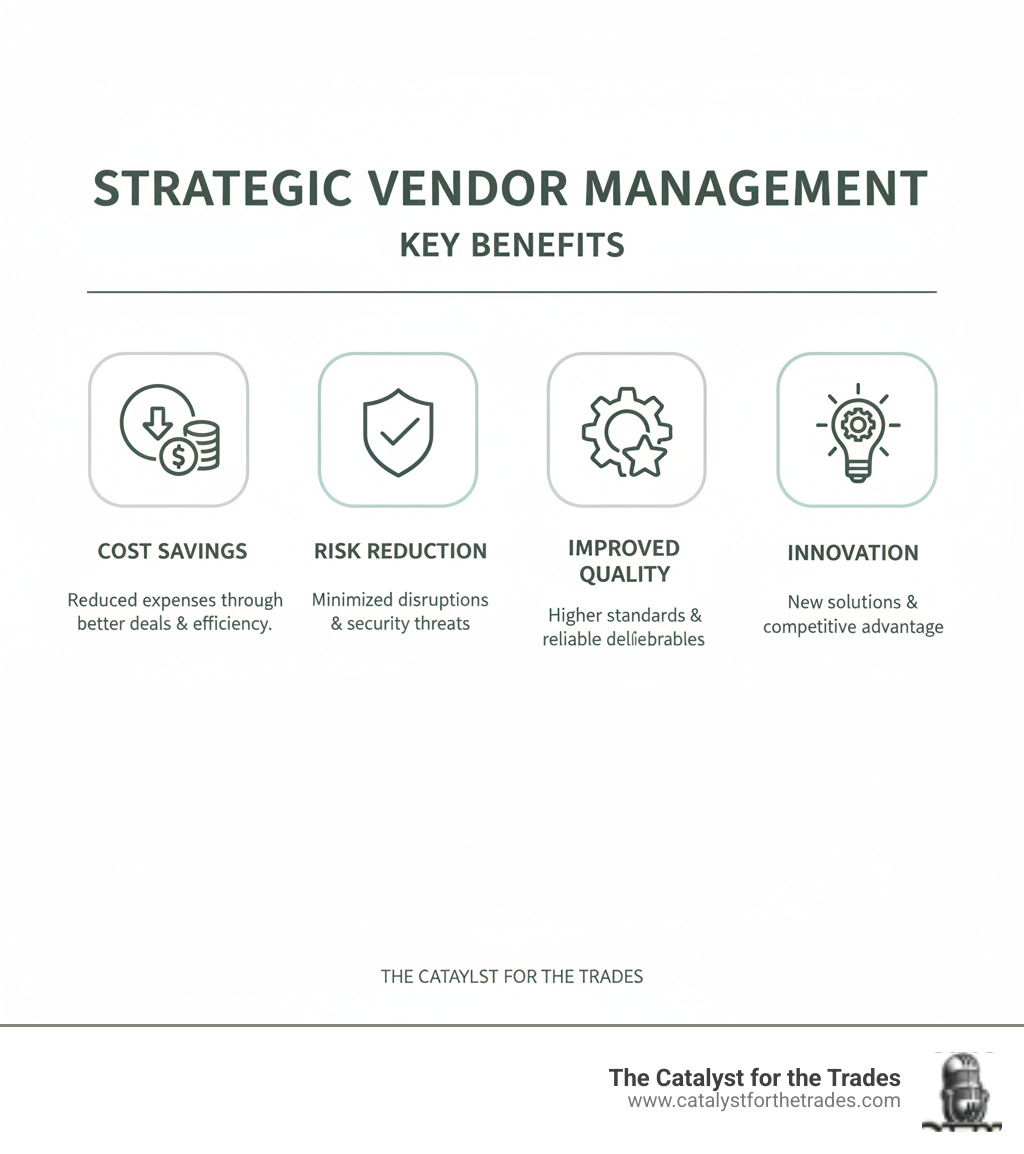Elevate your leadership. Explore top leadership conferences, gain insights, network strategically, and boost your career. Get the ultimate guide!

Supplier Success: Unlocking the Power of Effective Vendor Management
What Are Vendor Management Strategies and Why Do They Matter for Your Business?
Vendor management strategies are the essential blueprints for selecting, managing, and optimizing the external businesses that help your company run. For a trades business, this isn't just administrative paperwork; it's the core of your operational success. To manage your vendor relationships effectively and turn them into a competitive advantage, you must focus on these key areas:
- Set Clear Expectations: Don't leave anything to chance. Define precisely what you needfrom material specifications and delivery windows to communication protocolsand ensure vendors agree to these terms upfront in a formal contract or service level agreement (SLA). For a quick primer, see: Service-level agreement.
- Monitor Performance: Trust, but verify. Regularly check if vendors are meeting your standards for quality, timeliness, and cost. Use data and key performance indicators (KPIs) to track performance, not just gut feelings.
- Manage Risks: Every external partner introduces potential risks. Proactively identify and plan for potential problems like supply chain disruptions, quality control failures, financial instability in a supplier, or cybersecurity vulnerabilities from a software vendor.
- Communicate Openly: Foster a culture of transparent, two-way communication. Talk often with your vendors about upcoming projects, potential challenges, and performance feedback. This builds trust and allows you to solve problems together before they escalate.
- Build Strong Partnerships: Shift your mindset. See your best, most critical vendors as true partners in your success, not just interchangeable suppliers. When you invest in these relationships, they are more likely to invest in you with better service, pricing, and innovative ideas.
For any business in the trades, vendors are the lifeblood of daily operations. They provide everything from the specialized HVAC units and plumbing fixtures you install to the essential software that manages your scheduling and billing. But managing this complex web of suppliers isn't always easy. Poor vendor management can quickly spiral into chaos, leading to late deliveries that push project timelines, sub-par materials that cause callbacks and damage your reputation, and even significant security breaches. In fact, a study from Deloitte found that a whopping 87% of organizations have faced a disruptive incident with a third-party vendor in the last three years.
You don't want one of those disruptions halting a multi-day installation or hurting your hard-won reputation. Effective vendor management is your defense mechanism and your strategic lever. It helps you control costs, guarantee the quality of your work, and keep your operations running like a well-oiled machine. It transforms potential headaches into powerful strategic advantages.
This guide will show you how to transform your vendor relationships from a source of risk into a pillar of strength. You'll learn how to pick the right partners, set clear rules of engagement, and work collaboratively to drive your business toward greater profitability and success.
Quick wins you can apply today:
- Document the three most critical requirements you expect on every purchase order (specs, delivery window, contact).
- Identify your top 10 high-impact parts and confirm you have an A/B supplier for each.
- Define three KPIs you will measure for every strategic vendor and how you will collect the data.
- Schedule a recurring business review with your most critical supplier to align on upcoming demand and projects.
These small, practical steps build momentum. As you scale, they evolve into a disciplined, repeatable vendor management system that protects margins, lifts customer experience, and reduces avoidable surprises.

The 'Why' and 'What' of Strategic Vendor Management
When you're running a home service business, your vendors aren't just suppliersthey're the backbone of every single job you complete. Think about it: that emergency HVAC repair on the hottest day of the year depends entirely on your supplier delivering the right capacitor on time. The success and longevity of a major plumbing repipe project hinge on the quality of the materials, which must be durable enough to not fail your customer six months down the road. Your ability to schedule and dispatch technicians efficiently relies on the uptime and performance of your field service management software vendor.
This is where vendor management strategies become absolutely critical. We're not just talking about finding the cheapest supplier online and calling it a day. That's procurement, not strategy. Strategic vendor management is the art and science of building and nurturing relationships that drive tangible business value through cost savings, risk mitigation, quality improvement, and collaborative innovation.
The stakes are far higher than you might think. Poor vendor management is a silent killer of profit and reputation. It can lead to inflated operational costs from unmanaged contracts, critical security vulnerabilities in your tech stack, and complacent vendors who are slow to respond when you need them most. Many business owners don't fully grasp the deep, systemic risks that come with inadequate supplier oversight until a crisis hitsa key supplier goes out of business, a data breach occurs through a vendor's software, or a bad batch of materials leads to a dozen angry customer callbacks.
At The Catalyst for the Trades, we see a clear distinction: basic vendor management is essential to your 'run the business' activities, ensuring day-to-day operations continue smoothly. Strategic supplier relationship management, however, focuses on your 'grow the business' mission. You need that solid foundation of reliable, well-managed vendors before you can build something truly impressive and scalable.

The Core Benefits for Your Trades Business
When you implement solid vendor management strategies, you open up a cascade of powerful advantages for your business. These aren't just theories; they are measurable improvements to your bottom line and operational strength.
- Reduced Operational Costs: This goes far beyond simply negotiating a lower price. Strategic management leads to cost savings by consolidating spending with preferred vendors, optimizing payment terms and processes, and reducing waste from poor-quality materials. In fact, companies with structured supplier management programs typically see cost savings averaging around 12%.
- Improved Supply Chain Resilience: The disruptions of the past few years have taught every trades business a harsh lesson about supply chain vulnerability. Strategic vendor management directly addresses this by diversifying your supplier base for critical items, establishing backup plans, and improving visibility into your supply chain so you can anticipate shortages before they stop your jobs.
- Access to Supplier Innovation: Your vendors can become invaluable partners in innovation. When you build strong, collaborative relationships, they are more likely to bring you their best ideas first. This could be new, energy-efficient materials, smarter diagnostic tools that reduce time on site, or more efficient processes that give you a competitive edge. This approach aligns perfectly with the operational excellence mindset that helped George Donaldson scale a home services company to $100 million.
- Improved Service Quality for Customers: Your vendors' performance directly impacts your customers. With reliable parts, on-time deliveries, and high-quality materials backed by strong vendor relationships, you can deliver exceptional, consistent service every single time. This builds customer trust, generates positive reviews, and drives repeat business.
- Stronger Negotiating Power: When you have clear performance data, market intelligence, and a deep understanding of your spending, you enter negotiations from a position of strength. Discussions can shift from a race-to-the-bottom on price to a more strategic conversation about mutual benefit, value-added services, and long-term goals.
Basic vs. Strategic Vendor Management
Not every vendor relationship requires the same level of intense management. A key part of an effective strategy is knowing where to focus your energy. Understanding the difference between basic transactional management and a deep, strategic partnership approach is crucial for allocating your time and resources effectively.
| Aspect | Basic (Transactional) Vendor Management | Strategic Vendor Management |
|---|---|---|
| Focus | Cost-driven, short-term savings, availability. The primary question is, "What's the price?" | Value-driven, long-term partnerships, total cost of ownership. The primary question is, "How does this partnership improve my business?" |
| Relationship Type | Transactional, arms-length. Interactions are infrequent and often automated or based on purchase orders. | Collaborative, integrated. Regular communication, joint planning sessions, and shared goals are common. |
| Goals | Lowest price, basic compliance, on-time delivery. The goal is to acquire a commodity with minimal friction. | Mutual growth, innovation, risk mitigation, competitive advantage. The goal is to build a relationship that makes both businesses stronger. |
| Communication | Reactive, problem-focused. Communication typically happens only when an order is late, incorrect, or an invoice is due. | Proactive, strategic planning. Regular meetings to discuss performance, forecasts, and new opportunities. |
Transactional management works perfectly well for low-risk, easily replaceable goods and services. Think office supplies, janitorial services, or standard fasteners from a big-box hardware store. The impact of a single failure is low, and the focus is rightly on efficiency and cost.
However, when you're dealing with critical suppliers, a strategic approach becomes non-negotiable. The shift happens when a vendor's performance directly impacts your ability to serve your customers, when their failure could shut down a significant portion of your operations, or when they possess unique capabilities that give you a competitive advantage in the market. That's when you must move from simply managing costs to actively building a partnership that helps grow your business.
In practice, this shift looks like standardizing a short list of preferred vendors, aligning on demand forecasts, and measuring what matters. Start by defining a handful of shared metrics, such as on-time-in-full, defect rate, and first-contact resolution time, and review them regularly. For context on building measurable programs, see Key performance indicator. A simple quarterly cadence with clear action items will keep both sides accountable without creating unnecessary administrative burden.
What Are Vendor Management Strategies and Why Do They Matter for Your Business?
Vendor management strategies are the essential blueprints for selecting, managing, and optimizing the external businesses that help your company run. For a trades business, this isn't just administrative paperwork; it's the core of your operational success. To manage your vendor relationships effectively and turn them into a competitive advantage, you must focus on these key areas:
- Set Clear Expectations: Don't leave anything to chance. Define precisely what you needfrom material specifications and delivery windows to communication protocolsand ensure vendors agree to these terms upfront in a formal contract or service level agreement (SLA). For a quick primer, see: Service-level agreement.
- Monitor Performance: Trust, but verify. Regularly check if vendors are meeting your standards for quality, timeliness, and cost. Use data and key performance indicators (KPIs) to track performance, not just gut feelings.
- Manage Risks: Every external partner introduces potential risks. Proactively identify and plan for potential problems like supply chain disruptions, quality control failures, financial instability in a supplier, or cybersecurity vulnerabilities from a software vendor.
- Communicate Openly: Foster a culture of transparent, two-way communication. Talk often with your vendors about upcoming projects, potential challenges, and performance feedback. This builds trust and allows you to solve problems together before they escalate.
- Build Strong Partnerships: Shift your mindset. See your best, most critical vendors as true partners in your success, not just interchangeable suppliers. When you invest in these relationships, they are more likely to invest in you with better service, pricing, and innovative ideas.
For any business in the trades, vendors are the lifeblood of daily operations. They provide everything from the specialized HVAC units and plumbing fixtures you install to the essential software that manages your scheduling and billing. But managing this complex web of suppliers isn't always easy. Poor vendor management can quickly spiral into chaos, leading to late deliveries that push project timelines, sub-par materials that cause callbacks and damage your reputation, and even significant security breaches. In fact, a study from Deloitte found that a whopping 87% of organizations have faced a disruptive incident with a third-party vendor in the last three years.
You don't want one of those disruptions halting a multi-day installation or hurting your hard-won reputation. Effective vendor management is your defense mechanism and your strategic lever. It helps you control costs, guarantee the quality of your work, and keep your operations running like a well-oiled machine. It transforms potential headaches into powerful strategic advantages.
This guide will show you how to transform your vendor relationships from a source of risk into a pillar of strength. You'll learn how to pick the right partners, set clear rules of engagement, and work collaboratively to drive your business toward greater profitability and success.
Quick wins you can apply today:
- Document the three most critical requirements you expect on every purchase order (specs, delivery window, contact).
- Identify your top 10 high-impact parts and confirm you have an A/B supplier for each.
- Define three KPIs you will measure for every strategic vendor and how you will collect the data.
- Schedule a recurring business review with your most critical supplier to align on upcoming demand and projects.
These small, practical steps build momentum. As you scale, they evolve into a disciplined, repeatable vendor management system that protects margins, lifts customer experience, and reduces avoidable surprises.

The 'Why' and 'What' of Strategic Vendor Management
When you're running a home service business, your vendors aren't just suppliersthey're the backbone of every single job you complete. Think about it: that emergency HVAC repair on the hottest day of the year depends entirely on your supplier delivering the right capacitor on time. The success and longevity of a major plumbing repipe project hinge on the quality of the materials, which must be durable enough to not fail your customer six months down the road. Your ability to schedule and dispatch technicians efficiently relies on the uptime and performance of your field service management software vendor.
This is where vendor management strategies become absolutely critical. We're not just talking about finding the cheapest supplier online and calling it a day. That's procurement, not strategy. Strategic vendor management is the art and science of building and nurturing relationships that drive tangible business value through cost savings, risk mitigation, quality improvement, and collaborative innovation.
The stakes are far higher than you might think. Poor vendor management is a silent killer of profit and reputation. It can lead to inflated operational costs from unmanaged contracts, critical security vulnerabilities in your tech stack, and complacent vendors who are slow to respond when you need them most. Many business owners don't fully grasp the deep, systemic risks that come with inadequate supplier oversight until a crisis hitsa key supplier goes out of business, a data breach occurs through a vendor's software, or a bad batch of materials leads to a dozen angry customer callbacks.
At The Catalyst for the Trades, we see a clear distinction: basic vendor management is essential to your 'run the business' activities, ensuring day-to-day operations continue smoothly. Strategic supplier relationship management, however, focuses on your 'grow the business' mission. You need that solid foundation of reliable, well-managed vendors before you can build something truly impressive and scalable.

The Core Benefits for Your Trades Business
When you implement solid vendor management strategies, you open up a cascade of powerful advantages for your business. These aren't just theories; they are measurable improvements to your bottom line and operational strength.
- Reduced Operational Costs: This goes far beyond simply negotiating a lower price. Strategic management leads to cost savings by consolidating spending with preferred vendors, optimizing payment terms and processes, and reducing waste from poor-quality materials. In fact, companies with structured supplier management programs typically see cost savings averaging around 12%.
- Improved Supply Chain Resilience: The disruptions of the past few years have taught every trades business a harsh lesson about supply chain vulnerability. Strategic vendor management directly addresses this by diversifying your supplier base for critical items, establishing backup plans, and improving visibility into your supply chain so you can anticipate shortages before they stop your jobs.
- Access to Supplier Innovation: Your vendors can become invaluable partners in innovation. When you build strong, collaborative relationships, they are more likely to bring you their best ideas first. This could be new, energy-efficient materials, smarter diagnostic tools that reduce time on site, or more efficient processes that give you a competitive edge. This approach aligns perfectly with the operational excellence mindset that helped George Donaldson scale a home services company to $100 million.
- Improved Service Quality for Customers: Your vendors' performance directly impacts your customers. With reliable parts, on-time deliveries, and high-quality materials backed by strong vendor relationships, you can deliver exceptional, consistent service every single time. This builds customer trust, generates positive reviews, and drives repeat business.
- Stronger Negotiating Power: When you have clear performance data, market intelligence, and a deep understanding of your spending, you enter negotiations from a position of strength. Discussions can shift from a race-to-the-bottom on price to a more strategic conversation about mutual benefit, value-added services, and long-term goals.
Basic vs. Strategic Vendor Management
Not every vendor relationship requires the same level of intense management. A key part of an effective strategy is knowing where to focus your energy. Understanding the difference between basic transactional management and a deep, strategic partnership approach is crucial for allocating your time and resources effectively.
| Aspect | Basic (Transactional) Vendor Management | Strategic Vendor Management |
|---|---|---|
| Focus | Cost-driven, short-term savings, availability. The primary question is, "What's the price?" | Value-driven, long-term partnerships, total cost of ownership. The primary question is, "How does this partnership improve my business?" |
| Relationship Type | Transactional, arms-length. Interactions are infrequent and often automated or based on purchase orders. | Collaborative, integrated. Regular communication, joint planning sessions, and shared goals are common. |
| Goals | Lowest price, basic compliance, on-time delivery. The goal is to acquire a commodity with minimal friction. | Mutual growth, innovation, risk mitigation, competitive advantage. The goal is to build a relationship that makes both businesses stronger. |
| Communication | Reactive, problem-focused. Communication typically happens only when an order is late, incorrect, or an invoice is due. | Proactive, strategic planning. Regular meetings to discuss performance, forecasts, and new opportunities. |
Transactional management works perfectly well for low-risk, easily replaceable goods and services. Think office supplies, janitorial services, or standard fasteners from a big-box hardware store. The impact of a single failure is low, and the focus is rightly on efficiency and cost.
However, when you're dealing with critical suppliers, a strategic approach becomes non-negotiable. The shift happens when a vendor's performance directly impacts your ability to serve your customers, when their failure could shut down a significant portion of your operations, or when they possess unique capabilities that give you a competitive advantage in the market. That's when you must move from simply managing costs to actively building a partnership that helps grow your business.
In practice, this shift looks like standardizing a short list of preferred vendors, aligning on demand forecasts, and measuring what matters. Start by defining a handful of shared metrics, such as on-time-in-full, defect rate, and first-contact resolution time, and review them regularly. For context on building measurable programs, see Key performance indicator. A simple quarterly cadence with clear action items will keep both sides accountable without creating unnecessary administrative burden.
What Are Vendor Management Strategies and Why Do They Matter for Your Business?
Vendor management strategies are the essential blueprints for selecting, managing, and optimizing the external businesses that help your company run. For a trades business, this isn't just administrative paperwork; it's the core of your operational success. To manage your vendor relationships effectively and turn them into a competitive advantage, you must focus on these key areas:
- Set Clear Expectations: Don't leave anything to chance. Define precisely what you needfrom material specifications and delivery windows to communication protocolsand ensure vendors agree to these terms upfront in a formal contract or service level agreement (SLA). For a quick primer, see: Service-level agreement.
- Monitor Performance: Trust, but verify. Regularly check if vendors are meeting your standards for quality, timeliness, and cost. Use data and key performance indicators (KPIs) to track performance, not just gut feelings.
- Manage Risks: Every external partner introduces potential risks. Proactively identify and plan for potential problems like supply chain disruptions, quality control failures, financial instability in a supplier, or cybersecurity vulnerabilities from a software vendor.
- Communicate Openly: Foster a culture of transparent, two-way communication. Talk often with your vendors about upcoming projects, potential challenges, and performance feedback. This builds trust and allows you to solve problems together before they escalate.
- Build Strong Partnerships: Shift your mindset. See your best, most critical vendors as true partners in your success, not just interchangeable suppliers. When you invest in these relationships, they are more likely to invest in you with better service, pricing, and innovative ideas.
For any business in the trades, vendors are the lifeblood of daily operations. They provide everything from the specialized HVAC units and plumbing fixtures you install to the essential software that manages your scheduling and billing. But managing this complex web of suppliers isn't always easy. Poor vendor management can quickly spiral into chaos, leading to late deliveries that push project timelines, sub-par materials that cause callbacks and damage your reputation, and even significant security breaches. In fact, a study from Deloitte found that a whopping 87% of organizations have faced a disruptive incident with a third-party vendor in the last three years.
You don't want one of those disruptions halting a multi-day installation or hurting your hard-won reputation. Effective vendor management is your defense mechanism and your strategic lever. It helps you control costs, guarantee the quality of your work, and keep your operations running like a well-oiled machine. It transforms potential headaches into powerful strategic advantages.
This guide will show you how to transform your vendor relationships from a source of risk into a pillar of strength. You'll learn how to pick the right partners, set clear rules of engagement, and work collaboratively to drive your business toward greater profitability and success.
Quick wins you can apply today:
- Document the three most critical requirements you expect on every purchase order (specs, delivery window, contact).
- Identify your top 10 high-impact parts and confirm you have an A/B supplier for each.
- Define three KPIs you will measure for every strategic vendor and how you will collect the data.
- Schedule a recurring business review with your most critical supplier to align on upcoming demand and projects.
These small, practical steps build momentum. As you scale, they evolve into a disciplined, repeatable vendor management system that protects margins, lifts customer experience, and reduces avoidable surprises.

The 'Why' and 'What' of Strategic Vendor Management
When you're running a home service business, your vendors aren't just suppliersthey're the backbone of every single job you complete. Think about it: that emergency HVAC repair on the hottest day of the year depends entirely on your supplier delivering the right capacitor on time. The success and longevity of a major plumbing repipe project hinge on the quality of the materials, which must be durable enough to not fail your customer six months down the road. Your ability to schedule and dispatch technicians efficiently relies on the uptime and performance of your field service management software vendor.
This is where vendor management strategies become absolutely critical. We're not just talking about finding the cheapest supplier online and calling it a day. That's procurement, not strategy. Strategic vendor management is the art and science of building and nurturing relationships that drive tangible business value through cost savings, risk mitigation, quality improvement, and collaborative innovation.
The stakes are far higher than you might think. Poor vendor management is a silent killer of profit and reputation. It can lead to inflated operational costs from unmanaged contracts, critical security vulnerabilities in your tech stack, and complacent vendors who are slow to respond when you need them most. Many business owners don't fully grasp the deep, systemic risks that come with inadequate supplier oversight until a crisis hitsa key supplier goes out of business, a data breach occurs through a vendor's software, or a bad batch of materials leads to a dozen angry customer callbacks.
At The Catalyst for the Trades, we see a clear distinction: basic vendor management is essential to your 'run the business' activities, ensuring day-to-day operations continue smoothly. Strategic supplier relationship management, however, focuses on your 'grow the business' mission. You need that solid foundation of reliable, well-managed vendors before you can build something truly impressive and scalable.

The Core Benefits for Your Trades Business
When you implement solid vendor management strategies, you open up a cascade of powerful advantages for your business. These aren't just theories; they are measurable improvements to your bottom line and operational strength.
- Reduced Operational Costs: This goes far beyond simply negotiating a lower price. Strategic management leads to cost savings by consolidating spending with preferred vendors, optimizing payment terms and processes, and reducing waste from poor-quality materials. In fact, companies with structured supplier management programs typically see cost savings averaging around 12%.
- Improved Supply Chain Resilience: The disruptions of the past few years have taught every trades business a harsh lesson about supply chain vulnerability. Strategic vendor management directly addresses this by diversifying your supplier base for critical items, establishing backup plans, and improving visibility into your supply chain so you can anticipate shortages before they stop your jobs.
- Access to Supplier Innovation: Your vendors can become invaluable partners in innovation. When you build strong, collaborative relationships, they are more likely to bring you their best ideas first. This could be new, energy-efficient materials, smarter diagnostic tools that reduce time on site, or more efficient processes that give you a competitive edge. This approach aligns perfectly with the operational excellence mindset that helped George Donaldson scale a home services company to $100 million.
- Improved Service Quality for Customers: Your vendors' performance directly impacts your customers. With reliable parts, on-time deliveries, and high-quality materials backed by strong vendor relationships, you can deliver exceptional, consistent service every single time. This builds customer trust, generates positive reviews, and drives repeat business.
- Stronger Negotiating Power: When you have clear performance data, market intelligence, and a deep understanding of your spending, you enter negotiations from a position of strength. Discussions can shift from a race-to-the-bottom on price to a more strategic conversation about mutual benefit, value-added services, and long-term goals.
Basic vs. Strategic Vendor Management
Not every vendor relationship requires the same level of intense management. A key part of an effective strategy is knowing where to focus your energy. Understanding the difference between basic transactional management and a deep, strategic partnership approach is crucial for allocating your time and resources effectively.
| Aspect | Basic (Transactional) Vendor Management | Strategic Vendor Management |
|---|---|---|
| Focus | Cost-driven, short-term savings, availability. The primary question is, "What's the price?" | Value-driven, long-term partnerships, total cost of ownership. The primary question is, "How does this partnership improve my business?" |
| Relationship Type | Transactional, arms-length. Interactions are infrequent and often automated or based on purchase orders. | Collaborative, integrated. Regular communication, joint planning sessions, and shared goals are common. |
| Goals | Lowest price, basic compliance, on-time delivery. The goal is to acquire a commodity with minimal friction. | Mutual growth, innovation, risk mitigation, competitive advantage. The goal is to build a relationship that makes both businesses stronger. |
| Communication | Reactive, problem-focused. Communication typically happens only when an order is late, incorrect, or an invoice is due. | Proactive, strategic planning. Regular meetings to discuss performance, forecasts, and new opportunities. |
Transactional management works perfectly well for low-risk, easily replaceable goods and services. Think office supplies, janitorial services, or standard fasteners from a big-box hardware store. The impact of a single failure is low, and the focus is rightly on efficiency and cost.
However, when you're dealing with critical suppliers, a strategic approach becomes non-negotiable. The shift happens when a vendor's performance directly impacts your ability to serve your customers, when their failure could shut down a significant portion of your operations, or when they possess unique capabilities that give you a competitive advantage in the market. That's when you must move from simply managing costs to actively building a partnership that helps grow your business.
In practice, this shift looks like standardizing a short list of preferred vendors, aligning on demand forecasts, and measuring what matters. Start by defining a handful of shared metrics, such as on-time-in-full, defect rate, and first-contact resolution time, and review them regularly. For context on building measurable programs, see Key performance indicator. A simple quarterly cadence with clear action items will keep both sides accountable without creating unnecessary administrative burden.

Discover how leading home‑service companies are leveraging AI, subscription models, and digital‑first strategies.
Learn why private equity, automation, and customer‑centric tech are reshaping the trades.
Episodes you may like


Master business strategy development. Chart your course to growth, competitive advantage & profitability with our expert guide.

Unlock massive home service business growth! Leverage AI, build your team, and master customer experience for your thriving empire.
.png)



